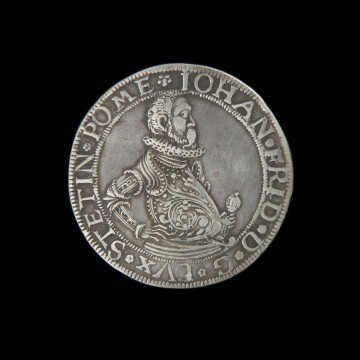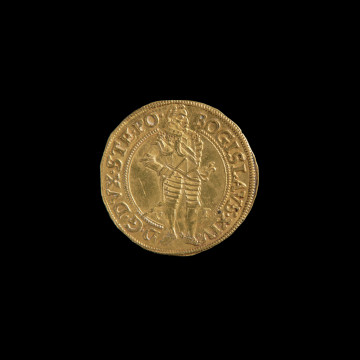
1/2 thaler
1594
National Museum in Szczecin
Part of the collection: Pomeranian coins
The coinage of Duke Bogislaw XIV (1620-1637) brought about a significant increase in the issuance of silver and gold coins. Massive thalers were minted to support the Imperial troops stationed in West Pomerania during the Thirty Years' War. Despite its neutrality policy, the Duchy as a part of the Reich had to pay a war tax (over 83 thousand thalers), and from 1627 it was obliged to maintain the occupying army. Thalers were usually of homogeneous iconographic form - the ruler's bust or half-figure and the coat of arms of West Pomerania. They were made in two mints, in Szczecin and Koszalin, but it is impossible to distinguish where individual pieces came from. It is assumed that the thalers containing the bishop title and a shield with a cross, i.e., the symbol of the bishopric, in the royal titles were made in Koszalin. In fact, there are many exceptions, and the matter is additionally complicated by the Szczecin goldsmith and engraver Gottfried Tabbert's signature of the, which can be seen on the coins from both mints. A very interesting thaler, similar to the imperial ‘armed’ type, with a half-figure of the Duke in armour, equipped with a helmet, sash and a commander's baton, the so-called regiment, appeared in 1628. This type of depiction highlights the attributes of a sovereign ruler able to defend his subjects. The reverse of the thaler provides the balance between the military overtones of both sides. i.e., a griffin in a fighting position with a sword and an open book (Bible) symbolises strength supported by faith in God. The beginning of the issue coincided with the Duke's unsuccessful efforts to bring about peace between Strzałów (Stralsund) and the besieging Imperial army. Thalers with this content were minted in 1628-1631 and, judging by the number of known variants of stamps (in inscriptions, shapes of images, signatures), the issues must have been crucial. The author of these coins was most probably Gottfried Tabbert, although his initials were not always placed on them. There is no other signature on the museum specimen, apart from a mysterious mark in the form of crossed hooks. Despite suggestions, it has not been explained that issues intended for war payments (taxes, salaries, ransoms) were marked that way. The motif only appeared on a series of thalers (also two shillings) from 1628-1630. It is known that this is not the mark of the mint master, Ulrich Bütkow, suggested earlier, but it cannot be excluded that issues coined according to lowered standards for war needs were such marked.
Genowefa Horoszko
Other names
Taler
Author / creator
Dimensions
cały obiekt: height: 2.3 mm, diameter: 44.2 mm
Object type
coin
Technique
minting
Material
silver
Creation time / dating
Creation / finding place
Owner
National Museum in Szczecin
Identification number
Location / status

1594
National Museum in Szczecin

1633
National Museum in Szczecin

around 1170 — 1176
National Museum in Szczecin
DISCOVER this TOPIC
Museum of King Jan III's Palace at Wilanów
DISCOVER this PATH
Educational path